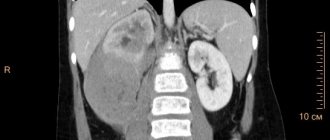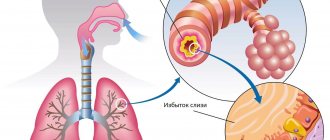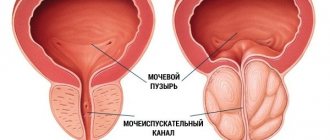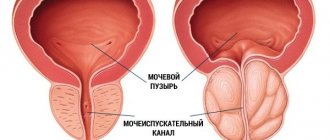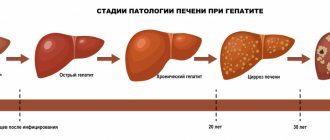The development of cystitis in men is provoked by microorganisms that are introduced into the bladder through the blood from other organs.
Inflammation of the bladder in men is quite rare. The start for the development of the disease can be a decrease in immunity, a person’s exposure to cold conditions for a long time. Only a specialized urologist can treat cystitis in men.
After carrying out the necessary tests and studies, a diagnosis is made and treatment is prescribed aimed at relieving inflammation and reducing pain.
The famous urology clinic named after. Fronshteina R.M. will allow you to undergo diagnostics using the latest technology equipment. Treatment of cystitis in men is carried out on an inpatient and outpatient basis by qualified medical personnel.
General information about male disease
Cystitis in men is an infectious disease. The prevalence of this disease in men is much less than in women. This is explained by the fact that it is more difficult for bacteria that cause the disease to enter the male body. The male urethra is longer, so the infection does not reach the internal organs of men as often as in women.
Cystitis is a disease that affects the genitourinary system, regardless of the person’s gender. The course and symptoms of the disease differ somewhat among representatives of different sexes, although there are common signs. Cystitis in men is a process of inflammation of the urinary system. With this disease, the mucous tissue of the bladder is affected, as a result of which the man experiences discomfort and cannot live a full life.
Manifestations of abnormal bladder activity: painful and frequent urination, the appearance of mucus and blood in the urine, repeated urges to visit the toilet at night. The patient may not immediately see a doctor; this is dangerous because of its consequences. Cystitis can become chronic and lead to other complications. In order not to progress the disease, try to contact experienced specialists at the Global Clinic Center in a timely manner.
What is cystitis, urethritis, prostatitis, what is the difference between them?
Urethritis is an inflammation of the mucous membrane of the urethra. The main causes of the disease: injuries and infections (usually STDs or poor hygiene).
Cystitis is an inflammation of the bladder, its mucous membrane and walls. It occurs both through the ascending route (through the urethra) and when an infection is introduced through the blood/lymph flow. Infection with pathogenic microorganisms is also possible when using a catheter in violation of aseptic rules.
Prostatitis is inflammation of the prostate gland in men. The pathology is accompanied by an increase in the size of the affected organ, which begins to block the normal outflow of urine. The causes may be sexually transmitted infections or the development of opportunistic microflora. Prostatitis also manifests itself as a complication after some other serious diseases.
According to statistics, cystitis most often occurs in women, but both sexes suffer equally from urethritis. This is due to the peculiarities of physiology. In men, the urethra is long and narrow, so pathogenic bacteria rarely enter the bladder. The result is local inflammation of the canal. In women, the urethra is short and wide, which provides the prerequisites for the spread of infection to the walls of the bladder.
For all of these diseases, it is extremely important to start treatment in a timely manner! In addition to unpleasant symptoms, there is a risk of another complication - the infection can ascend through the ureters to the kidneys.
Classification of cystitis
There are several signs that form the basis for the classification of the disease.
By methods of manifestation
According to the methods of manifestation, there are two types of cystitis:
- Spicy
- Chronic
Acute cystitis in men can occur:
- first;
- no more than one case per year;
- with a frequency of 2 or more times every 365 days.
For the occurrence of acute cystitis, there are unfavorable factors in the form of uncontrolled use of certain medications and thermochemical effects on a man. An infection that enters the body of men can also cause certain symptoms characteristic of acute stage cystitis.
The chronic form of the disease can be divided into the following subtypes:
- Latent (symptoms of cystitis in men in this case are smoothed out). The frequency of occurrence of the disease is more than two cases per year, the disease is stable or with rare periods of exacerbations.
- Persistent. The process of inflammation and development of cystitis is diagnosed twice a year or more often.
- Interstitial. This is the most severe form of the disease. Cystitis progresses and can lead to serious complications.
According to the etiology of occurrence
Based on this characteristic, doctors distinguish such forms of cystitis in men as primary and secondary. Primary cystitis is in no way associated with other pathologies of men. This is an independent disease. The secondary form may be the result of problems in the genitourinary system and other organs of the patient. Men with prostate adenoma, diseases of the spinal column, abnormal development of the bladder, or ingestion of foreign fragments should be prepared for this kind of disease.
By localization of inflammation
Cervical, diffuse, trigonitis, focal form of cystitis - this diagnosis is made depending on the location of the source of the disease. Each type of disease is characterized by its own symptoms: with cervical cystitis, urine cannot be retained, the patient often “runs” to the toilet; the diffuse form is characterized by the extensive spread of inflammation; With trigonitis, clots of blood and pus appear in the urine.
How to treat bladder inflammation
- During an exacerbation, bed rest is prescribed with a diet (spicy, fried and canned foods are excluded from the diet).
- Increased fluid intake.
- Uroseptics to relieve inflammation and spasms of the bladder mucosa (nolicin, palin, norbactin, furadonin).
- Antibiotics depending on the type of pathogen (ampicillin, oxacillin, cefazolin). Prescribed intramuscularly, the course of treatment is 10 days.
- Painkillers.
- Diuretic herbs in the form of decoctions and infusions.
- In some cases, when there is suspicion of the development of a tumor process, a cystoscopy is performed and material is taken for a biopsy.
- According to indications, instillations with protargol are prescribed.
Treatment is prescribed individually based on the results of the examination.
Causes of cystitis in men
Cystitis is most often provoked by various infections that penetrate the male body. The bladder, which contains intestinal, Pseudomonas aeruginosa, tuberculosis bacilli, staphylococci, gonococci, begins to malfunction, and inflammation of various etiologies and localization occurs. There are many unfavorable factors for the appearance of cystitis in men:
- weak immune system;
- powerful radiation exposure of men;
- allergy;
- prolonged and severe hypothermia;
- presence of infections;
- injuries in the bladder area.
Frequent stress, excessive passion for work, smoking, alcohol, and a disordered sex life have a detrimental effect on a man. Men who have undergone unprofessional surgical intervention in the area of the urethra and bladder should be warned about possible negative consequences. Trusting the professional doctors from the Global Clinic Center is the first step towards a successful solution to the problem.
Why choose treatment at the Urology Clinic named after. Fronshteina R.M.
- It is a leading institution in the field of urology.
- Service by medical staff is provided at the level of European quality.
- The clinic's staff includes world-renowned specialists.
- All services provided by the clinic are strictly confidential.
- When conducting examinations and treating patients, the latest laser and electronic technology is used.
- Treatment methods are focused on reducing trauma during endoscopic procedures.
- The use of an ultrasonic scalpel reduces the risk of blood loss during operations.
You can come to the clinic for a consultation from different regions and cities of Russia.
Bladder inflammation can be cured. It is imperative to take chemical medications, which must be prescribed by a doctor, and not self-medicate.
Symptoms of male cystitis
The most common symptoms of cystitis in men are:
- Frequent (often with difficulty and pain) urination.
- Change in urine odor.
- Presence of pus and bloody discharge in the urine.
- Burning and itching when urinating.
Specific symptoms may be accompanied by general negative signs: weakness, decreased ability to perform usual work, painful manifestations in the groin, scrotum, bladder, increased body temperature. A man with cystitis becomes nervous, irritable, vulnerable to other diseases - the presence of these symptoms varies from person to person. The intensity of the signs of the disease increases along with the neglect and progression of cystitis.
Diagnosis of the disease
If you complain of painful urination, you should contact a urologist. During the examination, the doctor consistently excludes other pathologies:
- sexually transmitted infections;
- prostatitis;
- prostate tumors;
- exacerbation of urolithiasis, renal colic.
In addition to an external examination, patients need to undergo a urine test, do a PCR test of a smear from the urethra, monitor the frequency of trips to the toilet and the volume of discharge, submit biomaterial for bacterial culture, have an ultrasound of the pelvic organs, and computed tomography.
Diagnostics
The success of treatment largely depends on timely diagnosis. Modern methods of diagnosis are used by medical specialists from the Global Clinic Center. The doctor who conducts the appointment carefully listens to the patient’s complaints, taking an anamnesis of the disease. After this, the patient will be asked to do a urine test. The Nechiporenko method and bacterial culture are effective diagnostic methods.
The speed and smoothness of the process of urine passage through the urethra and other organs of the excretory system can be determined by the uroflowmetry method. The use of an endoscope in cytoscopy makes it possible to examine the bladder from the inside. This method gives an accurate picture of possible organ pathologies.
The male type of cystitis can be diagnosed using an ultrasound of the prostate to identify the amount of residual urine. The use of ultrasound to examine the bladder is difficult due to the overcrowding of this organ. A blood test for general analysis is also prescribed to patients to identify the causes of the disease.
Treatment of urethritis, cystitis, prostatitis
All three of these diseases are diagnosed by ultrasound and laboratory urine tests. Urethroscopy is less commonly used. For treatment, antibiotics and antimicrobial agents, drugs to strengthen local immunity, and physiotherapy are used.
If you want to get a doctor’s advice on how to distinguish prostatitis from cystitis, undergo an examination and get rid of the disease, make an appointment at the Dr. AkNer in Moscow! This is an advanced center for urology, gynecology and reproductive medicine, where the most modern diagnostic technologies and treatment regimens are used. It’s easy to make an appointment with a doctor directly on the website or by phone!
Urologist, andrologist Akopyan Nerses Grigorievich.
Back to list of articles
Treatment
Treatment comes down to a whole range of effective measures that must be followed.
Medicines
The main drugs that fight back cystitis are antibiotics. The patient may be admitted to a hospital or take these medications on an outpatient basis. It all depends on how far the disease has progressed. Specific antibiotic preparations are determined by the doctor after determining the cause and nature of the disease and studying laboratory tests. Qualified specialists of the Global Clinic Center will take all measures to ensure that the treatment is as effective as possible. Doctors will prescribe medications against infections if this is the cause of the disease. For severe pain, effective painkillers will be recommended.
Phytotherapy
Decoctions of herbs that have a diuretic and anti-inflammatory effect will complement drug treatment. For cystitis, brew bearberry, lingonberry leaf, and horsetail. They will help to quickly relieve inflammation, “expel” residual urine from the bladder, and normalize the process of urination. The use of phytotherapeutic drugs should be discussed with your doctor and used in combination with medications.
Physiotherapy
This technique is not suitable for patients with exacerbation of the disease. The disease in a chronic form or after its acute period has passed can be treated with additional physiotherapeutic methods:
- electrophoresis;
- use of medicinal mud;
- treatment with magnets;
- UHF, etc.
Symptoms and signs of male cystitis, characteristic of acute and chronic forms of the disease
Acute cystitis is characterized by a frequent urge to urinate, while the amount of urine is minimal, about 15 ml; sometimes the urge is accompanied by urinary incontinence.
The presence of pain, burning and cutting when urinating is considered the main symptom of cystitis. In this case, the pain can be either very strong, almost unbearable, or quite tolerable. Pain occurs at the beginning of urination and at the end. It can also be difficult to empty the bladder, despite the urge. Between visits to the toilet, a man is usually tormented by aching pain in the groin, penis, and pubic area.
Acute cystitis may be accompanied by intoxication of the body, fever, severe sweating, chills, loss of strength, and headaches. In severe cases of the disease, it is recommended to hospitalize the patient.
Severe acute cystitis often takes on a gangrenous and hemorrhagic form. In this case, the urine in men becomes cloudy, mixed with blood and mucus, has an unpleasant odor, and its amount is reduced to a minimum and does not exceed 400 ml per day.
Chronic cystitis has less pronounced symptoms. The pain is usually moderate, frequent urges are not observed, there are no bloody impurities in the urine, only mucous. Despite this, the disease is easy to recognize, because the course of the disease occurs in waves and has both remissions and exacerbations.
Diagnosis and treatment of cystitis
The key to quick and effective treatment of cystitis is correct diagnosis and timely administration of appropriate therapy. Our center carries out all the necessary examinations for this disease: urological and gynecological examinations, ultrasound of the genitourinary tract, urine and blood tests and cystoscopy. Experienced urologists will help you get rid of the disease as soon as possible. The main thing is to contact a specialist at the first signs of the disease, so that cystitis does not become your “eternal companion.”
Reading reviews on the Internet about the treatment of cystitis, you may come across methods of treating cystitis using folk remedies or, for example, the widely advertised drug Monural. But self-medication in this matter is absolutely unacceptable! Only a urologist will be able to select the correct treatment regimen for you, including effective drugs for the treatment of cystitis, and will also prescribe the necessary follow-up examination after cystitis to prevent relapse.
We know how to treat cystitis! The method of treatment of cystitis in the multidisciplinary clinic "MedicCity" is selected individually by a urologist, taking into account the characteristics of each patient and examination data. Treatment of cystitis should be aimed both at suppressing the source of infection, and at increasing the body’s immunity and restoring normal vaginal microflora in women with cystitis.
Features of cystitis in women and children?
In this situation, I would like to say – “Poor women!” Cystitis is the cup that will not blow almost any of them. The most significant feature is the topical location of the urethra with the vestibule of the vagina and a short urethra with sufficient width.
For boys and men, cystitis is not typical. They are often a manifestation of other diseases:
- Anatomical features.
- Balanitis, balanoposthitis, phimosis.
- Urethritis.
- Prostatitis.
- Urolithiasis disease.
- Bladder diverticula.
- BPH.
- Etc.
And so on ad infinitum... This is the idea. If a boy or man is diagnosed with cystitis, further examination is necessary in 100% of cases.
And girls, starting from 6 months, are already at risk - synechiae, improper toileting of the external genitalia, poor hygiene, the beginning of sexual activity (there is even the concept of “honeymoon” cystitis), continued sexual activity, gynecological infectious diseases, pregnancy, childbirth, postmenopausal dry mucous membranes, prolapse of internal organs and disruption of the supporting function of the genitourinary diaphragm - THESE ARE ALL FACTORS of lower urinary tract infection, and as its manifestations - cystitis.
Characteristic signs of acute cystitis:
- small volume of urine (10-15 ml) with frequent intercourse;
- possible incontinence;
- the desire to urinate is accompanied by acute pain, especially at the beginning and end of urine output;
- urine has a putrid amber, cloudy consistency, blood, mucus, flakes.
Male cystitis in the acute phase can be accompanied by hyperthermia, intoxication, profuse sweating, chills and other signs of severe inflammation - the patient requires hospitalization for treatment in a hospital.
The chronic stage of cystitis manifests itself in a more restrained manner, with slight pain, without frequent urges or blood impurities (mucus is present). Like any other advanced pathology, this form of male cystitis is cyclical - remissions are replaced by exacerbations.


